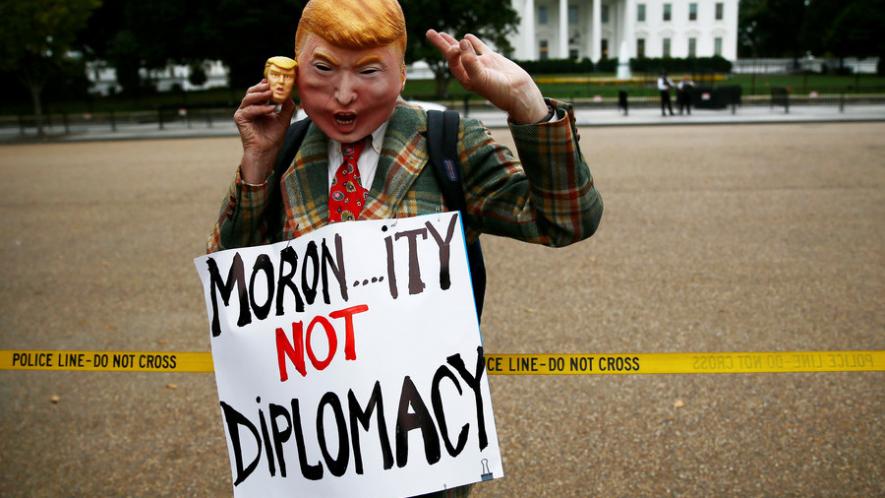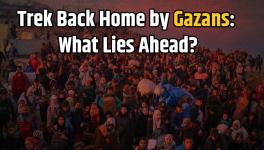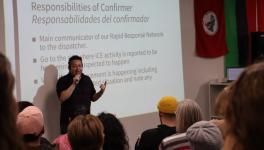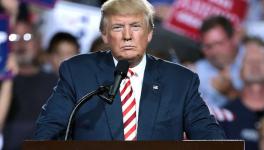Aiming at Iran and Shooting at the Nuke Deal

Months after refusing to re-certify the Iran nuclear deal, US President Donald Trump now either wants it ‘fixed’ or scrapped. This month, Trump gave the ultimatum putting pressure on European countries, which played a crucial part in finalising the 2015 international agreement to curb Iran’s nuclear program – to satisfy Trump.
“Despite my strong inclination, I have not yet withdrawn the United States from the Iran nuclear deal,” Trump said in a statement. “Instead, I have outlined two possible paths forward: either fix the deal’s disastrous flaws, or the United States will withdraw.”
“This is a last chance,” warned Trump.
Few days back, US Vice President Mike Pence during his visit to Israel reiterated the warning again. Pence’s visit comes in the backdrop of Trump’s disastrous move to recognise Jerusalem as Israel’s capital, officially burying the Oslo peace accord.
“The Iran nuclear deal is a disaster and the United States of America will no longer certify this ill-conceived agreement,” said Pence.
After killing the 1993 Oslo peace deal, Trump is now all set to shoot another – Joint Comprehensive Plan of Action (JCPOA). JACPOA was signed in 2015 between Iran, the P5+1 (the five permanent members of the United Nations Security Council—China, France, Russia, United Kingdom, United States—plus Germany) and the European Union. Under the technicalities of the deal, in lieu of lifting of international sanctions against Iran, Tehran agreed to eliminate its stockpile of medium-enriched uranium and cut its stockpile of low-enriched uranium by 98%. Additionally, Iran agreed to reduce by about two-thirds the number of its gas centrifuges for 13 years.
So, what does Trump want to fix in the deal? Actually, nothing! The target is not the deal, but Iran.
The International Atomic Energy Agency (IAEA), the monitoring authority of the deal, has repeatedly certified that Tehran is complying with the terms and condition of the deal. Also, IAEA director-general noted in a statement that U.N. inspectors are facing no problems in their verification efforts. Iran has given unprecedented access to the IAEA inspectors to all locations and, according to reports Iran remains under the most robust nuclear verification regime in the world.
Apart from IAEA, the European partner countries of the deal have also expressed their satisfaction with the inspection process. According to experts, the deal provides opportunities for the partners ‘to deepen their engagement’ with Iran and ‘build trust’.
In September last year, more than 80 of the world's leading nuclear nonproliferation specialists issued a joint statement reaffirming their support to the deal. They noted that JACPOA has “proven to be an effective and verifiable arrangement that is a net plus for international nuclear nonproliferation efforts.”
The deal was signed under the Obama administration, and it puts Iran at a ‘level playing field’ with the rest of the partner countries. Now, the crucial factor is that Trump hates both Obama and Iran. Back in the United States, the Trump administration is in reverse gear, undoing most of the Obama era polices- Obamacare, Planned Parenthood, Environment and Climate Change, Deferred Action for Childhood Arrivals (DACA) - basically whatever he could put his hands on.
President Trump, considered by many critics to be a megalomaniac, views Iran as an enemy. Iran, along with North Korea and Iraq is part of the ‘axis of evil’ group –first used by President George W. Bush in his State of the Union address in 2002. North Korea and Iran are still ‘free’ and continue to give US the nightmares of 1950s Korean war and the 1979 revolution (also overthrow of American friendly Shah and capture of US embassy in Tehran) respectively. The evil in Iran was ‘tamed’ as American forces invaded the country in 2003.
Iran “is responsible for so much instability,” Trump said in a May 2017 speech.
“Iran is an adversarial power that is working against the vital interests of the region. The deal doesn’t make Iran any better, so the deal doesn’t serve our interests,” noted James Jay Carafano, a foreign policy expert at the conservative Heritage Foundation who served on the Trump transition team.
The Middle East region is vital for US political and economic interests. According to political experts, although the Middle East produces ‘a quarter of world oil supplies, it holds between two-thirds and three-quarters’ of all known oil reserves. Though less than 10 percent of U.S. oil comes from the Middle East, the oil production in the region has direct impact on the stability of the global market. The oil embargo in 1973 by Arab states against US bumped the wind out of the global economy and helped trigger a stock market crash.
The embargo led to long gas lines and shapes U.S. foreign policy to this day and thus explains its interest in the Middle East. The Trump regime, changing the Obama policy of focus on alternative sources of energy wants to further strengthen the dependence on fossil fuel and coal.
Iran, for United States is a strong opposition to its expansion in the region. Iran’s influence in the Middle East is growing, as US Middle East strategy, backed by its allies (Saudi Arabia and Israel) continues to backfire. Iraq, Syria, Libya and recently Yemen- all having US forces on ground- are classic examples of the failure.
Washington’s attempt to impose its control and dominance over Iran goes back to 1953. According to the US National Security Council document, Central Intelligence Agency had extensive resources and its role in the 1953 ‘successful coup’ operation code name TPAJAX in Iran. The covert operation led overthrow of the democratically elected government of Prime Minister Mohammad Mosaddeq, and putting the dictatorship regime of Mohammad Reza Shah.
The US has been long trying to target Iran’s ballistic missile program. It’s important to note that this program does not violate either the nuclear deal or any international agreement. As long as Iran has ballistic missiles, any US military adventuring in the country will prove to be costly. In a move to push for international sanction or UN resolution, US had been accusing Tehran of providing Houthi rebels in Yemen with ballistic missiles. Contrary to the US claims, ballistic experts argue that the missile could be a variant of the Scud missile supplied to Yemen by North in 1990s or 2000, and is not from Iran.
The second option for United States to counter Iranian ballistic missile program and its increasing influence in the region is to scrap the present nuclear deal and ‘renegotiate’ a separate agreement, which would also cover the missile program.
Experts argue that there is no reasonable case at all to address Iranian ballistic missiles when Saudi Arabia, Israel and the US all have ballistic missiles pointed at Iran.
When protests against the neo-liberal economic policies and corruption were raging in Iran, hoping for a regime change Trump tweeted, “oppressive regimes cannot endure forever, and the day will come when the Iranian people will face a choice.”
But as soon the intensity of protests began to decrease, Trump administration renewed its attack on the deal. US Secretary of State Rex Tillerson announced on Monday that the US is sending a diplomatic team to Europe to work out a joint initiative aimed at amending the nuclear deal.
Russia, one of the parties to deal has called the US move as ‘blackmailing’ the European partners.
Get the latest reports & analysis with people's perspective on Protests, movements & deep analytical videos, discussions of the current affairs in your Telegram app. Subscribe to NewsClick's Telegram channel & get Real-Time updates on stories, as they get published on our website.





















